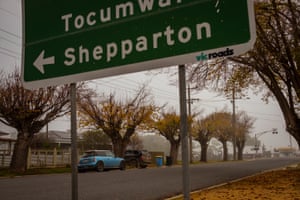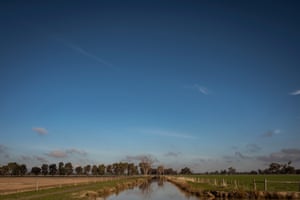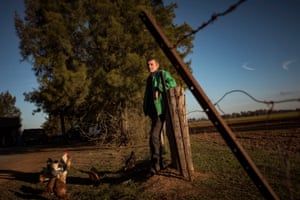The federal government gave $8m of $20m earmarked to progress high-speed rail to a consortium led by a man who has no expertise in major infrastructure projects, who had been a bankrupt and who was once a National party candidate.

The Consolidated Land and Rail Australia consortium, better known by its acronym Clara, is headed by Nick Cleary, a would-be property developer from the southern highlands of New South Wales.
Cleary is a man with big dreams. Clara has sold bureaucrats and ministers on a vision so large it’s almost eye-watering: a high-speed rail network between Melbourne and Sydney that would open the way for not one but eight new cities, each between 200,0000 and 600,000 people, to be constructed along its route.
They would rise from the paddocks over the next 50 years, taking the pressure off Sydney and Melbourne as workers moved to the regions, but still with access to highly paid jobs just an hour away by rail.
Some of the new centres would be planned for the outskirts of existing regional towns, helping to revive their economies.
“The policy on population has failed because we have failed to overcome the tyranny of distance,” Cleary says. “Between now and 2061 we are going to grow the population by 15 million. Our plan is to build cities at scale connected by high-speed rail.”

Proponents say the “value uplift” of turning rural land into city and suburban blocks – generating billions for Clara – would more than cover the cost of the rail line, well north of $100bn, plus the estimated $5.5bn of infrastructure such as roads, water, waste services, schools and hospitals needed in each new city.
It’s a vision to transform the settlement patterns of Australia entrenched for more than 200 years. And all to be achieved by the private sector, with only minimal government involvement.
“How do you eat an elephant? One bite at a time,” Cleary says.
But can Clara deliver on the vision?
Too good to be true?
The $8m given to Clara is for a business case for the first stage, a line between Melbourne and Shepparton, and two new cities at Nagambie and Shepparton. Clara’s plan, which at this stage does not specify a technology, says it can cut the travel time between Melbourne and Shepparton from three hours to just 32 minutes.
Too good to be true?
An investigation by the Guardian has revealed that Clara has no office – its principal place of business, according to Asic records, is the office of its law firm, DLA Piper in Melbourne. It has just $422,000 in paid-up capital and so far has no major shareholders or directors with expertise in infrastructure projects, property development, construction or financing.
Asic searches show a web of companies behind Clara, but the ultimate controlling shareholders are Cleary, his wife, Erin Cleary, and his assistant, Alexandra Johnson, who acts as Clara’s contact point.
Cleary says there is a separate consortium agreement and “there are a number of firms that are funding us while we pass those milestones” of developing the business plan.

He names the computer giant Cisco; the Japanese industrial company Hitachi; the urban planners Roberts Day and Clarke Hopkins Clarke; the consultant PWC; and DLA Piper.
“There are 16 firms who have signed up to the Clara consortium,” Cleary says. “They are part of Clara to deliver a strategic vision. Our financing is coming from large-scale institutional money down the track. We have to go through those milestones.”
He says a number of companies are providing in-kind support. DLA Piper acknowledged that the firm was doing work for Clara, but expressed surprise that it was listed as the consortium’s principal place of business.
Cleary also says he has secured some of the crucial land around the sites of the first two new cities. “We have some land in our control around those locations. It’s around those areas, about 10km from Shepparton.”
But Clara has also had some setbacks. When it launched in 2016, its advisory board included several high-profile former politicians including the former Victorian premier Steve Bracks, the former NSW premier Barry O’Farrell and the former federal trade minister Andrew Robb. Only Robb remains.
Robb describes himself as an enthusiastic supporter. “I think there will be a level of surprise about the comprehensive nature of the business plan,” he told Guardian Australia.
“It doesn’t have to be all taxpayer dollars. Governments are increasingly using value creation as a source of funding. Hong Kong hasn’t spent any taxpayer funds on its underground. Instead it identifies where it will build stations and buys up the land, then builds the retail centres and apartments.”
The Melbourne wealth management company Newhaven was also involved, but its principal, Jay Grant, who served as the consortium’s managing director, pulled out. So did some of the Americans Clara had approached, including a former US transport secretary, Ray LaHood.
‘He had our hopes right up’
The Guardian has also learned that many of the options Clara signed with landowners along the proposed route for the high-speed train have lapsed, leaving a bitter taste for farmers who were swept away by Cleary’s promises of cities rising from the paddocks.
Rather than put the line though the centre of Shepparton, a move likely to lead to objections, Cleary’s plan involves finding the greenest of greenfield sites. He began securing land around the eight sites for proposed new cities in 2016. One is at Tallygaroopna, population 579, just north of Shepparton.
The farmers who signed up with Cleary in 2017 thought they were on the cusp of a gold rush that would change their lives. But two years on Cleary has not been seen for months, and the options agreements have lapsed.

Trevor Hosie, who has 120 hectares with “a few sheep and cattle and a bit of irrigation” says it was October or November when he last saw Cleary.
Cleary and his offsider, Alex Johnson, brought teams of engineers and investors to visit the site, but last year the visits stopped, and no one in Tallygaroopna has seen Cleary for about eight months.
“I signed an agreement but it was all their way,” Hosie says. “There was a three-month option, then another one, but then it ran out in October last year.” He had been promised nearly $3m for his farm.
Greig Buckland, a dairy farmer, is particularly aggrieved. “We signed up to it in 2016,” Buckland says, having first spent money on lawyers.
“He told me he’d let me know when it was going public and he did call me the day before it was in the media. He was on TV saying they would be turning the first sod in 2018. But 12 months went by and nothing. I could have sold the dairy farm in that 12 months.”
He add: “He had our hopes right up there. I have tried ringing him many times but got nowhere.”
Other farmers, including Neville Moss of Glenara Angus Stud, were sceptical. Moss says he told Cleary: “I’ll sign when you hand over the money to one of the others.” He is still waiting.
Around Nagambie it’s a similar story. Philip Deane, 65, signed up to sell his land, 8km north-east of the town. He went to the launch at RMIT and was excited by the vision outlined by Cleary and his associates, but especially by the $20m Cleary was offering for his farm.
But the option has now lapsed, along with Deane’s dreams of a comfortable retirement. His son, Wesley, has come back to run the farm.
Cleary insists he still has options on land earmarked for the eight cities.
‘We have not gone and assessed that’
Cleary’s background seems to have passed the Department of Infrastructure by when it funded him.
Around the southern highlands, memories of Cleary’s plan for developing dairy farms, his own included, are still raw. Several families lost money.
Asic records show that the agricultural finance company CNH Capital filed to place him in bankruptcy in May 2010. Cleary sought to discharge the bankruptcy a year later but failed to provide written information about his property and income. He was discharged from bankruptcy in June 2013.
In an excruciating session of Senate estimates last year the deputy secretary of the then Department of Infrastructure, Regional Development and Cities, Luke Yeaman, and the head of rail policy, Andrew Hyles, were forced to admit they were not aware of Cleary’s bankruptcy or that Clara had just $422,700 in capitalisation.
“We fundamentally assess the proposed project that was put in front of us by the company on the basis of the criteria that were in front of us,” Yeaman said. “We didn’t go through a detailed assessment of the company’s history,” he said under questioning from the Labor senator Murray Watt.
Watt then played his ace. “Was the department aware that Mr Cleary is a longtime member of the National party, and that at one time he was even a vice-chairman of the New South Wales Nationals?”

Hyles said there were a range of partners with the company and that these were “international firms”. “They’re supporting Clara with their own in-kind contributions towards the work of building up this business case,” he said.
He said he was aware of Clara securing land options. “We have not gone and assessed that ourselves at this stage,” Hyles said.
Who the responsible minister was when Clara was chosen as frontrunner to build the most important infrastructure project of this century is less easy to say.
Responsibility for fast rail is shared between the minister for infrastructure and transport and the minister responsible for cities – and the people occupying both jobs have changed regularly.
Angus Taylor, who hails from Goulburn, has been an advocate for the Sydney-to-Melbourne fast rail, as it would go through his electorate. He was minister for cities at the time of the first call for submissions, which yielded 26 proposals, and he was still the minister during the process to whittle it down to a field of 13 which went on to stage two. The transport minister was Darren Chester, a National.
But soon after the stage two bids were submitted in late November 2017, both portfolios changed. Barnaby Joyce became transport minister and Paul Fletcher became cities minister on 20 December.
By February 2018 Joyce was dealing with more personal crises: revelations of his affair with his staffer Vikki Campion had come to light, costing him his marriage, the deputy prime minister’s job and his portfolio.
Campion by this time was working in the office of the Victorian Nationals MP Damien Drum, whose seat covers Shepparton and Tallygaroopna.
By the time the winners were announced on 9 March 2018, the new Nationals leader, Michael McCormack, was transport minister, while Fletcher remained cities minister.
“The whole assessment was considered by cabinet,” Hyles told estimates. He said the three selected after stage two were top of the list the department recommended.
Will bold plan impress government?
Clara and the other two successful groups that shared the $20m are due to hand their business cases to the government imminently.
The other two projects are more conventional and involve state governments and the private sector. They are an upgrade to the line between Sydney and Newcastle, proposed by the NSW government, and a proposal for faster rail between Brisbane and Nambour proposed by North Coast Connect, a consortium involving the property developer Stockland, the engineering firm SMEC and urban planners Urbis. The Queensland government is giving in-kind support.
Whether Clara will again impress the bureaucrats with its bold plan remains to be seen. Theoretically, the value uplift model does not depend on government funding. But government support, both state and federal, would be essential to realise a 50-year plan crossing state boundaries.
The government has left itself an exit strategy with Clara.
“The Australian Government funding contribution to the Clara proposal is up to $8,000,000,” its fact sheets on high-speed rail say. “However, it should be noted that financial support for the development of a business case does not indicate Australian Government support for delivery of a project.”
The question is: would such a move set high-speed rail back another decade or more?
• Next: How faster rail could change our cities
Know more? anne.davies@theguardian.com


View all comments >